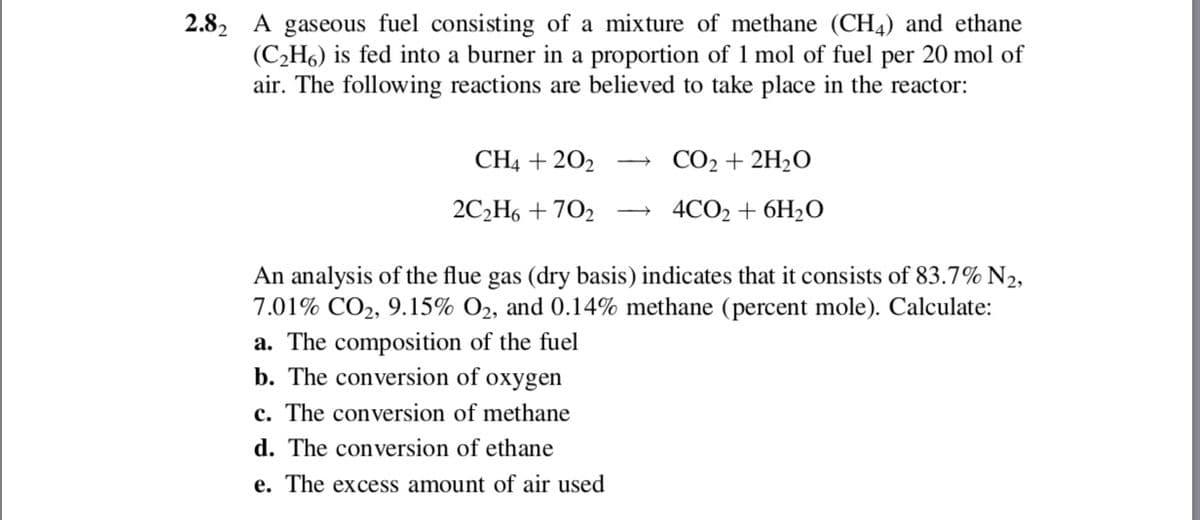2.82 A gaseous fuel consisting of a mixture of methane (CH4) and ethane (C2H6) is fed into a burner in a proportion of 1 mol of fuel per 20 mol of air. The following reactions are believed to take place in the reactor: CH4 + 202 CO2 + 2H2O 2C2H6 + 702 - 4CO2 + 6H2O An analysis of the flue gas (dry basis) indicates that it consists of 83.7% N2, 7.01% CO2, 9.15% O2, and 0.14% methane (percent mole). Calculate: a. The composition of the fuel b. The conversion of oxygen c. The conversion of methane d. The conversion of ethane e. The excess amount of air used
2.82 A gaseous fuel consisting of a mixture of methane (CH4) and ethane (C2H6) is fed into a burner in a proportion of 1 mol of fuel per 20 mol of air. The following reactions are believed to take place in the reactor: CH4 + 202 CO2 + 2H2O 2C2H6 + 702 - 4CO2 + 6H2O An analysis of the flue gas (dry basis) indicates that it consists of 83.7% N2, 7.01% CO2, 9.15% O2, and 0.14% methane (percent mole). Calculate: a. The composition of the fuel b. The conversion of oxygen c. The conversion of methane d. The conversion of ethane e. The excess amount of air used
Introduction to Chemical Engineering Thermodynamics
8th Edition
ISBN:9781259696527
Author:J.M. Smith Termodinamica en ingenieria quimica, Hendrick C Van Ness, Michael Abbott, Mark Swihart
Publisher:J.M. Smith Termodinamica en ingenieria quimica, Hendrick C Van Ness, Michael Abbott, Mark Swihart
Chapter1: Introduction
Section: Chapter Questions
Problem 1.1P
Related questions
Question

Transcribed Image Text:2.82 A gaseous fuel consisting of a mixture of methane (CH4) and ethane
(C2H6) is fed into a burner in a proportion of 1 mol of fuel per 20 mol of
air. The following reactions are believed to take place in the reactor:
CH4 + 202
CO2 + 2H2O
2СН6 + 702
4СО2 + 6H20
An analysis of the flue gas (dry basis) indicates that it consists of 83.7% N2,
7.01% CO2, 9.15% O2, and 0.14% methane (percent mole). Calculate:
a. The composition of the fuel
b. The conversion of oxygen
c. The conversion of methane
d. The conversion of ethane
e. The excess amount of air used
Expert Solution
This question has been solved!
Explore an expertly crafted, step-by-step solution for a thorough understanding of key concepts.
This is a popular solution!
Trending now
This is a popular solution!
Step by step
Solved in 5 steps

Knowledge Booster
Learn more about
Need a deep-dive on the concept behind this application? Look no further. Learn more about this topic, chemical-engineering and related others by exploring similar questions and additional content below.Recommended textbooks for you

Introduction to Chemical Engineering Thermodynami…
Chemical Engineering
ISBN:
9781259696527
Author:
J.M. Smith Termodinamica en ingenieria quimica, Hendrick C Van Ness, Michael Abbott, Mark Swihart
Publisher:
McGraw-Hill Education

Elementary Principles of Chemical Processes, Bind…
Chemical Engineering
ISBN:
9781118431221
Author:
Richard M. Felder, Ronald W. Rousseau, Lisa G. Bullard
Publisher:
WILEY

Elements of Chemical Reaction Engineering (5th Ed…
Chemical Engineering
ISBN:
9780133887518
Author:
H. Scott Fogler
Publisher:
Prentice Hall

Introduction to Chemical Engineering Thermodynami…
Chemical Engineering
ISBN:
9781259696527
Author:
J.M. Smith Termodinamica en ingenieria quimica, Hendrick C Van Ness, Michael Abbott, Mark Swihart
Publisher:
McGraw-Hill Education

Elementary Principles of Chemical Processes, Bind…
Chemical Engineering
ISBN:
9781118431221
Author:
Richard M. Felder, Ronald W. Rousseau, Lisa G. Bullard
Publisher:
WILEY

Elements of Chemical Reaction Engineering (5th Ed…
Chemical Engineering
ISBN:
9780133887518
Author:
H. Scott Fogler
Publisher:
Prentice Hall


Industrial Plastics: Theory and Applications
Chemical Engineering
ISBN:
9781285061238
Author:
Lokensgard, Erik
Publisher:
Delmar Cengage Learning

Unit Operations of Chemical Engineering
Chemical Engineering
ISBN:
9780072848236
Author:
Warren McCabe, Julian C. Smith, Peter Harriott
Publisher:
McGraw-Hill Companies, The